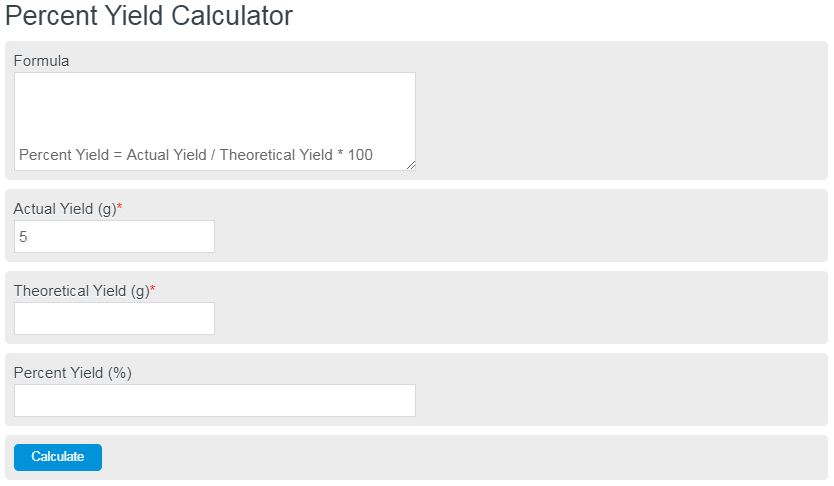Enter the theoretical yield and the actual yield of your chemical reaction to calculate the percentage yield of said reaction.
- Percent Error Calculator
- Reverse Percentage Calculator
- Actual Yield Calculator
- Relative Error Calculator
Percent Yield Formula
The following formula is used to calculate a percentage yield.
Y = AY / TY *100
- Where Y is the percent yield (%)
- AY is the actual yield (g)
- TY is the theoretical yield (g)
To calculate the percentage yield, divide the actual yield by the theoretical yield, then multiply by 100.
Percent Yield Definition
A percent yield, also referred to as a percentage yield, is the ratio of the actual yield of mass of a chemical reaction to the theoretical yield that the reaction should produce.
How to calculate percent yield?
When it comes to chemistry, calculating the percent yield of a reaction is pretty straightforward. It’s a simple percentage calculation based on the theoretical yield and observed result. You may have stumbled on the page looking for the percent yield of something other than a chemical reaction; you can still use this calculator! Simply enter the max yield in the theoretical section, and the actual yield, and it will create the percentage yield. This could be the square footage yield or yield of a sheet.
In chemistry, the units are often recorded in grams when it comes to chemical reactions. Still, this calculator can be considered unitless since the result is a percentage. Therefore, if the units match, you will yield something relevant.
FAQ
What factors can affect the percent yield of a chemical reaction?
Several factors can affect the percent yield, including incomplete reactions, side reactions, loss of product during recovery, measurement inaccuracies, and the purity of reactants.
Is it possible to achieve a 100% percent yield in chemical reactions?
While theoretically possible, achieving a 100% percent yield in practical chemical reactions is extremely rare due to losses and inefficiencies that occur during the reaction and product recovery processes.
How can the percent yield be improved in a chemical reaction?
Improving percent yield can involve optimizing reaction conditions, using purer reactants, minimizing product loss during recovery, and employing techniques to reduce side reactions.
Can percent yield be greater than 100%? If so, what does it indicate?
Yes, a percent yield can be greater than 100%, which typically indicates errors in measurement, impurities in the reactants, or problems in the calculation of the theoretical yield.

